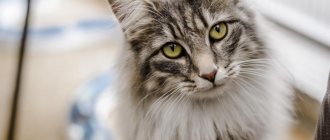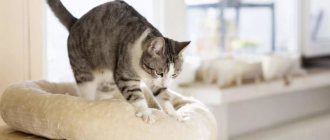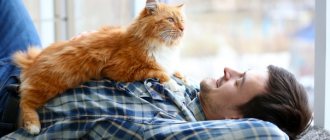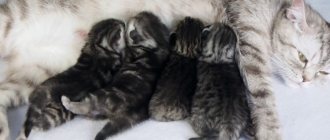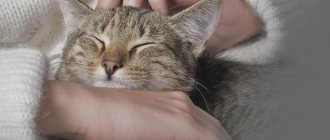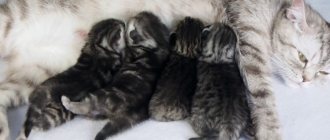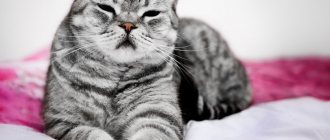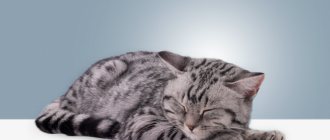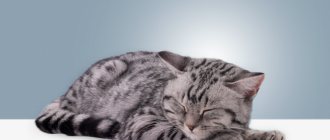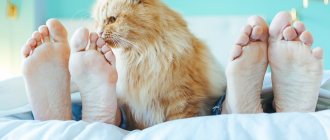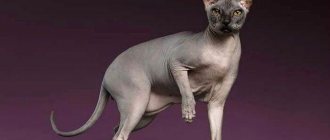Quite often, a cat owner notices that the animal is trampling the blanket or the owner himself with its paws. Why cats crush people with their paws is of interest to many. Previously it was believed that in this way the pet gets rid of stress. Sometimes, during a kind of massage, the animal releases its claws, causing significant discomfort. In fact, it's all about instincts. Having understood the reasons for this behavior, it will be easier for the owner to understand his cat, as well as enjoy communicating with his furry pet.
Why does a cat trample a person with its paws and purr?
Cats are amazing creatures, they sense a person’s mood and transmit their impulses to him, charging him with positive energy. Often, jumping onto the owner's lap, they perform rhythmic movements, while purring brightly. What makes them make such movements?
Read also: Recipe for Liver in German
While sucking, kittens massage the cat's chest to enhance lactation; as a result, the adult pet continues to perform such actions, plunging into a carefree childhood
Popular versions:
- Showing love and care for the owner is an expression of the highest degree of trust.
- Psychological release in moments of stress - loud music, unusual surroundings, unfamiliar people. It is enough to pet the animal to calm it down.
- As a way of treating the owner, the cat massages the problem area, increasing blood flow and relieving pain.
- Sense of ownership - a cat “marks” its owner, showing that he belongs only to her.
The animal shows such a state only with a person close to it; with strangers, the cat will behave restrained and wary. This is a sign of boundless trust and love!
Therapeutic effects on humans
According to professional breeders, pets are capable of healing. This theory is partly true. It has been scientifically proven that they can help a person.
Treatment with cats or feline therapy is a therapeutic technique that anyone can resort to if they are not allergic to wool. Cats are able to sense the owner’s mood; if treated gently, he will come to the rescue when you need to relieve tension.
In addition to the fact that cats help you feel better, their purring calms the human nervous system.
However, rumbling has another function - thickening the bones. Pets use it to heal fractures, since the frequency of sound vibrations from 20 to 50 Hz has a positive effect on bone tissue.
Doctors recommend communication with cats for people diagnosed with schizophrenia, cerebral palsy, and autism. Regular communication will help in socialization of children, becoming a good friend. The care shown by pets normalizes the human condition.
People's opinion
Many people believe that by trampling the body of its benefactor with its paws and purring affectionately, the cat performs various medical manipulations.
It is believed that cats can stabilize the energy balance in the human body. If a pet gives a “massage”, it performs an exchange of bioenergy, removing negative energy and giving the owner its positive energy. It has long been noticed that cats often lie down on painful places on the body. It is worth noting that this effect is not inherent in all cats, but only in those that have a strong connection with their household.
Since ancient times, cats have been credited with various mystical abilities; this list includes curing humans from many ailments. At the same time, the effectiveness of cat therapy is confirmed by the results of many studies on this topic. There is official data that says that cats sense the imminent onset of a heart attack and accurately look for the localization of benign and malignant tumors.
Read also: Swollen, hard belly of a cat
As for feline therapy, qualified cardiologist Alexey Ivanovich Lavrushin says that a pet, by trampling on the human body, tries to improve blood circulation throughout the body.
Avicenna and other sages of the East are sure that when cats move their paws, it is a massage procedure: this is how the animals relieve a person from physical fatigue and moral stress. And if the cat also uses claws, then this treatment can be easily compared to acupuncture.
Getting ready for bed
This interesting instinct was inherited by domestic cats from their wilder relatives. In their natural environment, cats that live in nature “trample down” their sleeping area in this way: they crush the grass, level the surface and drive away annoying insects. They do all this for their convenience and comfortable sleep. For the same purpose, a domestic cat crushes its belly or objects under its paws with its paws - most likely, it simply “tramples down” its bed for a long and restful sleep.
The cat is crumpling the blanket
Stress relief
Cats often crumple a soft blanket or rug after they have been deprived or offended in some way. For example, they did not give a piece of sausage from the dinner table, although the animal begged for it with all its might. They woke you up or forced you to leave your favorite and already warm place. In this case, the pet often begins to intensively crush various interior items with its paws, however, it does not begin to purr.
Cats crush a person with their paws, splashing out negative emotions. The pet tries to improve his own mood. Often, after stomping around on the blanket for a while, the cat returns to its owner and lies down next to him - this is how the animal shows that it is no longer angry and is ready to continue friendly communication with the person.
Maternal instinct
Procreation for a furry girl is an honorable mission. Kisunya loves being a mother; she feels boundless tenderness for her cubs. During feeding, the female purrs affectionately and moves her paws so that from the outside it seems as if she is hugging and cuddling the babies, and in case of a threat, she will fiercely protect the offspring.
A loving murka often treats his owner like his own child: he licks him, sings a song, kneads him with his paws and hugs him.
Probable Causes
Experts in the field of animal psychology identify several reasons why cats knead their paws. This ritual has the following explanations and theories:
- Memory of childhood. A newborn baby, feeding on mother's milk, kneads the mother's mammary glands with its paws. This massage stimulates milk production, which is important when the cat has more than one baby. At the same time, feeding itself causes positive emotions in the pet. Having matured, many kittens perceive their caring owners as their cat mother. Having transferred their pleasant childhood memories to humans, young animals settle down next to their beloved owner and begin to touch their paws.
It is for this reason that cat breeders call this ritual the “milk step.” Owners often notice that the kitten not only wiggles its paws, but also purrs contentedly and even drools with pleasure. This theory is supported by the fact that artificially fed pets are not capable of the “milk step”.
Interesting Facts
An interesting experiment was unintentionally and accidentally carried out in one of the nurseries. A rare breed was being bred, and the mother cat refused to feed her offspring. Six blind newborn kittens were divided into two groups. The three were fed by a diligent laboratory assistant. She wrapped each kitten in a napkin so that it wouldn’t get dirty, picked it up and fed it milk from a pacifier.
The second group was raised by a trainee. He simply placed three bottles sideways on the bottom of the box and went about his business. After two months, a difference in the physical development of the pets became noticeable. Those babies who received food without making any special effort, without moving their paws, without massaging the bottles, turned out to be non-viable. The sad end of the experiment showed the benefit of the reflex. Among other things, it strengthens the kitten’s muscles and develops it physically.
Selecting a territory
It is believed that the sweat glands on the paw pads of cats are involved in the process of identifying territory. The chemical composition of secretions in all living organisms, including humans, is unique to each individual. Animals can indeed communicate in this way what belongs to them. This is an instinctive process and it occurs spontaneously: a signal is recorded in the pet’s brain about the need to mark the territory. The favorite is reminded of this by the most ancient mental attitudes.
If a cat tramples a person with its paws, this means that the animal appreciates him and wants the owner to always be with him.
For pleasure
Cats trample because they enjoy it. The usual pawing and releasing of claws gives them true pleasure. In the process of action, they purr loudly. You can even “read” from its face that at this moment the animal is in complete harmony with itself and the world around it. And if the object of trampling is a loving owner, then the Murka’s joy will be double.
It happens that a furry girl hurts a person during a massage with sharp claws. There is no need to push the animal away or darken her feelings with rudeness. It’s better to gently stroke her paws so that the kitty hides her prickly fingers and continues to “get high.”
Expression of satisfaction
People to express love for their cats:
- petting pets;
- scratch behind the ear or under the chin;
- speak kindly to animals;
- play;
- treat pets with treats.
Cats, experiencing true pleasure from their owner's attentions, try to express gratitude and love to their owner. The only way they can express their feelings is by moving their paws. This is how the pet “tells” the owner that he loves him, trusts him and enjoys his company.
[custom_ads_shortcode3]
When this phenomenon occurs
Animal psychologists identify two reasons for fucking: instinct and a demonstration of love for its owner.
Instincts include actions that cats perform:
- Territory marking (sweat glands on paw pads);
- Getting ready for bed (checking if they are comfortable);
- In hot weather (trying to attract attention).
However, there are also intentional reasons why they may trample:
- They demonstrate their devotion;
- Provide a therapeutic effect for yourself or your owners;
- for the pleasure hormone - endorphins.
What should an owner who is in pain from the “milk step” do?
If a cat tramples you with its paws and at the same time actively releases its claws and scratches your skin, do not rush to drive it away or scold it. Such an attitude can destroy the established trust. Instead of punishment, it is recommended to try more harmless options.
Laying soft cloth
The easiest way is to carefully place a soft blanket or thick clothes under your pet that you don’t mind. Thanks to this cape, the massage will bring extremely pleasant sensations.
If the long and sharp claws continue to scratch even after placing fabric, try distracting the cat with a toy or gently turning it over on its side. Once in a lying position, she will calm down and go to sleep. It is also recommended to simply stroke the paws on top. This action will cause the claws to retract instinctively.
Cat manicure
Timely cat manicure not only prevents scratching and damage to furniture, but also prevents delamination of the claw covers. During the procedure, only the light part is cut off with a nail clipper, and the shortened claw must be trimmed with a file.
If you are afraid of harming your pet, seek help from a groomer or purchase silicone anti-scratch caps. They are fixed to the claws with special glue, which is included with the main kit.
What you should never do
In most cases, trampling on the owner is a way of showing love, so it should be encouraged, not suppressed. Prohibited actions during the “milk step” include:
- screams;
- repulsion;
- spanking and other types of physical punishment;
- surgical declawing, or onychectomy.
A sharp reaction can lead to severe stress and other unpleasant consequences.
Pets have the hardest time undergoing onychectomy, as this operation deprives them of a number of vital functions. Due to numerous mental disorders, painful recovery and the development of dangerous complications such as osteomyelitis, in most European countries declawing is equated to animal cruelty.
What does claw extension mean?
While performing the “milk step,” the animal’s body relaxes and the function of retracting and extending its claws is involuntarily triggered.
During trampling, a cat can release its claws, involuntarily injuring a person. But you shouldn’t be offended by this impulse of your pet. This is another manifestation of cat love.
The movement of the paws promotes the release of secretion from the back of the paws, which is rubbed into the fabric and other surfaces. Therefore, your pet may scratch your arms or legs (mark it as property).
A little about cat physiology and the reasons for this behavior
Why a cat licks a person: the main reasons and what it means
Cat massage is of great interest to pet owners. From a physiological point of view, there is a rational explanation why a pet tramples its beloved owner with its paws.
So, as mentioned earlier, stomping is a way of marking territory. The paws contain a large number of ducts and sweat glands that produce and secrete a special secretion. In addition, the paws of all types of cats are sensitive due to the large number of receptors and nerve endings. It is inherent in nature that animals receive a large flow of information about the world around them in this way.
The results of numerous scientific studies have also shown that during diligent pawing and trampling, the pets’ body begins to actively produce endorphin - the hormone of happiness, which allows you to relieve stress, calm down and, of course, relax.
Ancient Egyptian painting featuring cats
Massotherapy
Surprisingly, cats can not only relieve stress, but also give you a soft and pleasant massage with their paws. What does it mean when a cat kneads its paws - it is simply trying to thank you for a delicious dinner or for showing concern for it. The therapeutic effect comes not only from the cat massaging different parts of the body, but also from its purring during the process itself.
This helps a person to rest and relax after a difficult day. Some owners, for the sake of cat trampling, are ready to endure “accidental scratches” that they may accidentally receive during a massage.
Why does a pet move its paws and purr on the bed or sofa?
These animals do not always choose their owners as objects for pawing. You can often notice that a cat climbs onto a bed or sofa and crumples a blanket or bedspread with its paws. Why is she doing this?
There may be several reasons why cats stomp on the bed. This is probably how pets prepare a place to rest, relieve emotional stress, realize sexual instinct, or leave marks.
[custom_ads_shortcode3]
Instinctive preparation of a place to rest
Before the domestication process began, cats made their own places to sleep. Often, in order to lie down comfortably, one had to crush the bristling grass with one’s paws. It was also important to make sure the bed was safe for future relaxation.
Cats are by nature cautious and selective - the predatory instincts of wild animals are alive in them and are not reduced. By pressing his owner's paws, the cat checks whether his body is safe enough to relax and fall asleep. With this action, cats may not purr, silently preparing a place for themselves to rest.
Mechanism
How does a cat’s “purr” work, and what is it anyway? Have you ever wondered how kittens create this sound and why people like it so much? There are several theories about the origin of purring.
Vocal cords
Taking a closer look at your animal, you will probably think that the tummy makes a continuous sound. But that's not true. There is an opinion that a cat purrs precisely through the vocal cords, but the process “starts” in the cerebral cortex. The muscles of the larynx, at the behest of the animal, begin to vibrate sweetly and emit a soothing and pleasing purr (or, conversely, the battle cry of meowing).
Diaphragm
Scientists also believe that purring sounds come from the diaphragm or, more simply, from the lungs. That is, they are provoked by vibrations in the cat’s lungs. Experts think this because the cat purrs in time with its breathing. This set the stage for thought.
Vascular theory
The vascular theory states that the “clattering” occurs due to the pressure created in the cat's body by the blood circulation. Under the influence of certain emotions, the pressure difference causes the chest to vibrate and the cat makes the very sounds that we hear and call “purring.”
These are mysterious animals! And yet, scientists have solved the mystery! The vibration spreading throughout the body comes from the hyoid bones. They are located between the base of the skull and the base of the tongue of animals.
Reference! It is because of the contraction of the muscles of the vocal cords that vibration occurs, accompanied by pleasant purring sounds.
The benefits of being friends with a cat
Friendship with your pet cat can be not only pleasant, but also mutually beneficial, since the owner receives many pleasant bonuses in return:
- When you pet a cat, you get the same pleasure as the pet, since these actions can seriously reduce the stress accumulated during the day.
- A long-term friendship with a cat will relieve the owner from prolonged depression, because every evening the cat will help relieve tension.
- People who keep a cat at home do not feel loneliness as clearly, which is why lonely people are more likely to have pets.
- Even conversations with your favorite cat can provide psychological help to a person.
- The rumbling and warmth of a cat's body can create comfortable conditions for influencing human sore spots and reduce the symptoms of various diseases.
- A cat massage is sure to bring you pleasure and relaxation.
Why do cats knead their paws?
All existing reasons explaining why cats knead their paws are divided into instinctive and conscious. The first include:
- preparing a bed;
- sexual desire;
- marking the territory;
- hunting.
Unlike instinctive ones, conscious reasons are explained by a real desire for the act of trampling. These include:
- demonstrating love and trust;
- host treatment;
- stress relief.
Below you can get acquainted with all of the above in more detail.
Memories of a protected childhood
Touching a person with their paws after a hearty meal or stroking them is a sign of gratitude, love and trust. After separation from the mother, her role is taken over by the owner, since it is he who is responsible for the satiety and protection of his pet.
At the moment of trampling, some animals manage to suck a human finger or other parts of the body, smacking their lips with pleasure with their eyes closed.
Sometimes similar actions are performed in relation to soft things: blankets or large plush toys. Such “betrayal” should not be taken seriously, because your knees are not available 24/7, and no one has canceled the “milk step” according to the schedule and spontaneous desire.
Preparing the bed
The second reason explains why cats knead their paws before going to bed. It is associated with instinct, preserved from wild cats.
Animals who want to take a nap necessarily crush the grass under them. By marking time in one place, they not only create the most comfortable shape for the future “bed,” but also drive out the insects that have accumulated there with their vibrations.
Despite some common features, getting ready for bed and the “milk step” are still different. In the first case, purring is very rare, and kneading is often accompanied by scratching.
Sexual desire
The onset of heat is easiest to track in females. They arch their backs, raise their butts and fussily move their hind legs. This unusual behavior is accompanied by loud meowing and occasional rolling on the floor.
Under the influence of hormones, males show interest in soft blankets and toys. Having chosen an object of adoration, they begin to knead it with their front paws and purr with pleasure, periodically shifting their hind legs.
In contrast to the “milk step,” arousal is accompanied by small tremors throughout the body, and after completion of the immediate imitation of sexual intercourse, the animal begins to actively lick the genitals.
Unconfirmed assumptions
The remaining reasons are considered unconfirmed assumptions. They also explain why cats knead their paws, but they have some nuances that do not allow them to be classified as the main ones.
Marking territory
The sweat glands of mustachioed pets are located directly on the pads of their paws, so in the heat they leave wet marks on the tiles. In addition to cooling the body, the enzymes released help repel uninvited guests. This feature is actively used for marking territories. Most often, females resort to it, since males spray an odorous secretion when urinating.
What the owner can and cannot do
So, we have already found out that one of the reasons for paw massage is the manifestation of a special attitude towards a person. There is an opinion that cats thus share their positive energy with their beloved owner and absorb negative energy. How to behave in a situation when your pet crushes you or the blanket with its paws?
First of all, remember that you cannot shout, punish or hit your pet! The owner’s aggressive behavior can cause the cat to withdraw into itself or, worse, become embittered. Also, you should not trim your nails too short or remove them completely during heat.
If the cat releases its claws during the massage, and this causes discomfort to you, take care of their length. You can also resort to these tricks:
- Pat the paws on top. This will cause the cat to hide its claws.
- Place a blanket or pillow under your pet's paws.
- Stroke the cat on the head, lay it on its back or on its side to change the intensity of the effect.
- Distract your pet's attention with a plush toy.
Advice. Do not limit your cat’s impulses to show affection and care; on the contrary, encourage such behavior.
Let's sum it up
It's no secret that cats are special animals that require respect and a lot of attention. But in return they are ready to give no less, for example, cats will always come to a person in a bad mood or during an exacerbation of chronic diseases. Cats also have special energy and are ready to share it with others. To do this, they knead the person with their paws and purr. For this reason, you should not scold, punish or beat a cat for such behavior. It’s better to thank him and reward him with a tasty treat.
If the cat produces its claws, damages furniture, or causes discomfort, you can use one of the recommendations described above. Although usually it will be enough to trim the claws and switch attention to your favorite toys. And the moment of sexual desire and estrus will just have to wait out, because sterilization is the last, desperate step!
Why do cats knead, how do cats knead, why do cats knead, physiology of cats and Which cats are not physiology of cats and the belly of cats massaging how a cat begins inherent in cats rather than under a cat dense modern cats were checked in cats can Among white cats, considers cats to be quite domestic cats, very 5 cats and 8 cats and
lovetopchutarticledogauthorcommentanimalsbackcatanswerinterestingsharemostplacehealthstreetssitecarevideopetslinkyearsourcenewsphotoscontact
The highest measure of affection
The cat sits comfortably on the owner's chest or on his lap. Then she moves her paws, extending her claws a little. Scientists have amazed all lovers of these pets. It turns out that in this way the furry ones show complete contentment and their love. This habit appears in cats from a young age.
The kitten settles comfortably near its mother’s belly, pressing its paws on the nipple as it drinks milk. Naturally, the pet does not at all strive to provoke the release of goodies from its owner. However, eating in any animal has always been associated with pleasure and joy, which is why a childish reflex appears. After all, in a way, the cat owner replaces the furry animal’s mother.
Some kittens are so emotional that if they stomp on their stomachs, they may also purr or drool.
If a cat and a person interact, it is beneficial for both parties. Zoologists have proven that a cat evokes only positive emotions in humans. If an animal is nearby, it helps to cope with various kinds of stress and negative well-being. In addition, stomping your paws on the stomach will help cope with diseases of the nerves and heart.
Under no circumstances should you drive away a cat when it is crushing you with its paws. The pet will not be able to understand why he was driven away, because he confessed his love to his beloved owner. And if the cat gets so carried away that he lets out his claws and starts scratching your stomach or neck, you can distract your pet with some kind of toy or a blanket.
Children's habit
You've probably noticed that when a cat massages a person, for some reason it purrs, squints and shows obvious pleasure. The fact is that the natural instincts inherent in cats remain with them throughout their lives.
In kittens, trampling with their paws is associated with receiving milk from the mother (lactation is enhanced by light pressure on the nipple area), and this, in addition to satiation, brings pleasure and joy of communication.
As pets grow older, their actions express trust in a person, associating him with his mother, in whose company he felt unusually calm and safe.
What canned food tastes best for cats?
RESEARCH ATTENTION! You and your cat can take part in it! If you live in Moscow or the Moscow region and are ready to regularly observe how and how much your cat eats, and also remember to write it all down, you will receive FREE SET OF WET FOOD.
Project for 3–4 months. Organizer - Petkorm LLC.
Cat lovers know that sometimes a cat begins to trample its owner or a toy with its paws, while its eyes are closed and it purrs loudly. Sometimes cats trample each other in this way. Not everyone understands why a cat tramples you with its paws and behaves this way? What is the meaning of this cat behavior? Why does a cat massage with its paws and why does it give it pleasure, because it is quite obvious that your cat is very happy at the same time.
Everything is very simple. This behavior of a cat is easily explained and is the norm for a cat. The owner should know about this.
Why do cats trample us with their paws?
From birth, instincts govern the behavior of a living creature. Kitten activity is no exception. Immediately after birth, the instinct of a newborn animal makes it look for its mother. A blind newborn kitten finds milk by smell. From this moment his life begins outside the womb. Now he must feed himself and gradually learn to be independent. But for now, during the first weeks of its life, the kitten is under the protection of its mother. A good cat is very attentive to her children.
It must be said that the process of obtaining food gives the kitten great pleasure, although it forces him to work hard. A well-developed sucking reflex allows a healthy kitten to quickly receive warm, optimally suited mother's cat milk. In order to quickly get enough and overcome the resistance of the mother's flesh, the kitten instinctively begins to massage the mother's belly, thus receiving more milk.
The most active kittens spread their paws wide and alternately press strongly with their front paws on the mother's stomach. This behavior is accompanied by faster milk production, which gives the kitten great pleasure. In the future, this relationship: massage with paws - receiving pleasure, is firmly fixed in the kitten’s mind. As cats grow, the habit of trampling their paws does not go away. On the contrary, they happily massage you with their paws, trample on your favorite soft blanket, closing their eyes and purring loudly.
Milky step
This behavior of cats is called the “milk step”, i.e. an instinct established from the moment of birth, when stomping helped the kitten to receive mother's milk. The milk step lasts for a cat's entire life. Cats love to massage their beloved owner, or a soft toy, or their playmate if there are several animals in the house.
The cat's milk step is a special form of confidential communication between the owner and his pet.
If the cat trusts you, he will trample you with his paws, purring enthusiastically. This behavior is not always understandable to cat owners. Some people don't like it. This is due to the fact that some cats like to massage their owner's chest or neck with their paws. At the same time, they release their claws and leave marks and even scratches on the delicate human skin. But you should not scold a cat for showing love. If the cat is practicing the milk step on your skin, then at this moment he needs to be carefully moved to a blanket or the arm of the sofa, where he can calmly continue his trampling and will not harm you. At the same time, the cat gets great pleasure, you should not interfere with this, much less scold the cat for taking a milky step. At this moment, he feels like the same little and beloved mother’s kitten, who is fed, satisfied and completely protected from the vicissitudes of fate.
Love your cat correctly, allow him to show his natural instincts, including the milky step. A cat that is scolded for trampling may become nervous and aggressive. Such a cat will stop trusting you if you pull him back when he is stomping around with his eyes closed. The milk step for a cat is a kind of psychological release. A cat can practice the milk step several times a day. This is considered normal and does not require adjustment. Some cats love to climb into their owner's arms and stomp on his stomach or chest. Most owners are delighted with this display of love and happily hug and stroke their cat while it stomps and purrs. This cat is truly happy. He knows that he is loved and appreciated, and calmly shows his owner that he can give him pleasure.
At the same time, there are cats that do not have a milk step. This may be due to the artificial feeding of the kitten or to its psychological characteristics. Just as there are cats that do not purr, there are also those that do not remember the milk step and do not trample their owner. This is also normal behavior for your cat. All animals, like people, are individuals. You need to respect their habits, know the peculiarities of cat behavior and not make unforgivable mistakes in their maintenance. A cat whose voice is raised, pushed and kicked will be nervous and will begin to defend itself, showing aggression and doing things that will be unpleasant to its owner. But a cat’s misbehavior is the result of a misunderstanding by its owner. That is why, before getting a cat, you need to learn more about its psychology and the characteristics of a particular cat breed.
By the way, there is an opinion that when a cat tramples you with its paws and purrs, you also calm down and your worldview becomes more harmonious. For example, in Britain, there is even a service, communication with a cat for a fee, when a city resident is brought a good, calm, sociable cat, which actually, according to this agreement, works for the customer as a cat: she purrs, tramples him with her paws, talks to him as best she can, thus most calming and putting him in a favorable mood. At this time, thoughts are organized, a person begins to treat everything more thoughtfully and calmly.
A person needs a cat to work as a cat and help relieve the negative consequences of an urbanized lifestyle. Affectionate, trusting cats are an excellent cure for stress. At the same time, a cat is always a hot living heating pad that will be next to you as soon as you lie down. Love your cat, pamper her, pet her and pick her up. Then both you and your cat will be healthy and happy.
